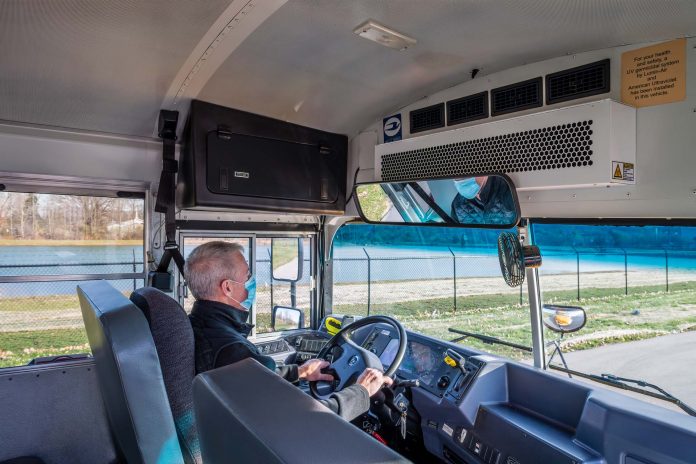The school bus is an important part of a school’s facilities, where students spend a considerable amount of their daily school time. School buses are the safest way to travel to and from school and are the only transportation option for some students.
School systems are in the process of determining how to best allocate the large amount of Elementary and Secondary School Emergency Relief (ESSER) funds, which were made available under the American Rescue Plan. They’ve been provided to improve the health of their constituents, and to ensure that their facilities are prepared for and avoid potential closures. So, let’s compare the air in school buses to classrooms.
The Wells-Riley model was developed by William F. Wells and Richard L. Riley in the late 1970s to quantify the risks associated with airborne transmission of respiratory diseases. The variables that affect the rate of infection include time, the infectivity of the disease, and the concentration of the infectious particles. There have also been many recent publications and some excellent computational fluid dynamic models showing how the risk of infection increases as the concentration of contaminants spreads within a classroom.
Since we can’t easily control time or the infectivity of the disease, how can we minimize disease transmission by reducing the “concentration”? Concentration is the number of infectious particles per volume.
A typical classroom for 25 students is roughly 1,050 square feet with a 9-foot ceiling, or 378 cubic feet per person. A typical 77-passenger school bus has 22 cubic feet per person. Imagine telling your students, teachers and parents that due to COVID-19, you were going to reduce the capacity in one of your classrooms made for 25 students to 50-percent capacity, and that you’d still fit 214 people. You read that right; 50-percent capacity in your school bus is like 214 people in a 25-person classroom.
The American Society of Heating, Refrigerating and Air-Conditioning Engineers (ASHRAE) and the Centers for Disease Control and Prevention (CDC) provides some excellent recommendations on how to reduce the concentration of contaminants inside classrooms. ASHRAE 62.1 Ventilation for Acceptable Indoor Air Quality has been adopted as code throughout the U.S. and sets guidelines for outside air. A classroom should bring in 10 cubic feet of clean outside air every minute (cfm) for the number of people in that space, plus 0.12 cfm per square foot of the space. In our example, that works out to 500 cubic feet per minute of clean outside air to dilute indoor contaminants in the classroom. ASHRAE 62.1 also states that the outside air intake must be more than 25 feet away from a thoroughfare with high traffic volume, like a bus parking or idling area.
If we applied the same criteria for the classroom to the school bus, we would need 800 cubic feet per minute of clean air to dilute contaminants in the school bus. How much clean outside air do we actually bring into a school bus? Even if a bus has air conditioning, there is zero outside air induced through it. Some buses do have small dash HVAC systems that bring in small amounts of outside air, but the only outside air that typically comes into a school bus is through an open window or vent. Bus drivers don’t have control of student’s windows, so a student can close their window because of outside conditions like rain, temperature and noise—or for any other reason they want. The quality of the outside air induced into the bus is poor, as bus windows are hopefully never more than 25-feet from the road, or the parking/idling area as prescribed by ASHRAE.
Scientific studies like “Reducing Air Pollution Exposure in Passenger Vehicles and School Buses” performed at the University of California, Los Angeles point out that high levels of traffic emissions are associated with pulmonary and cardiovascular health risks, especially for children who “are in the developing stage for pulmonary function and immune system. In addition, exposures to particulate pollutants were also found to be associated with poor academic performance.”
Amid a pandemic and with no better option, it’s better to open a window to reduce contaminant concentration. But the federal government has given us funds so that we don’t have to say, “We don’t have better options.”
If open windows and vents are not the best options, what else is available? And how does that compare to the classroom? Again, ASHRAE and the CDC set guidelines for classrooms. The recommendations are simply to improve filter efficiency as much as possible and supplement with ultraviolet germicidal irradiation, especially when outside air and filtration options are limited.
Related: In Pursuit of Clean School Bus Air
Related: Cleaning the Air Starts with Education on School Bus Role
Related: Clearing the Air
ASHRAE recommends a minimum MERV-13 filter for the reopening of classrooms. Filters are rated on MERV levels from low to high, based on the particles that they remove. Dr. Brent Stephens of the Illinois Institute of Technology published a report for the National Air Filtration Association, titled, “HVAC filtration and the Wells-Riley approach to assessing risks of infectious airborne diseases.” The report concludes that MERV-13 filters remove 87 percent of total droplet nuclei expelled during human activities. Typical bus filters are about MERV-2, which are not very effective at removing contaminated particles. The regular bus filter is there to try to keep the coil clean, not protect humans.

To summarize, the school bus has the most people per volume of any part of a school’s facilities. The school bus also has the lowest amount and worst quality of outside air available and the poorest filters.

The good news is that there are options available for school systems to improve the air in their school buses. Dr. William Bahnfleth, chair of the ASHRAE Epidemic Task Force, testified in front of the House Committee on Transportation and Infrastructure earlier this year. During his testimony, he said, “The density of people is ordinarily much higher than in buildings. This density inherently increases the risk of short-range transmission, and it is difficult, if not impossible, to isolate passengers.” He also stated, “Code minimum ventilation and MERV-13 filter efficiency should be viewed as baseline requirements that may not be sufficient. … Air cleaners may be used as a supplement … The best-established technology (to supplement ventilation and filtration) currently is disinfection with germicidal ultraviolet light.”
If school systems spent 1.2 percent of their ESSER money on improving the worst air in their school facility—the school bus—they could have a system installed including any UV bulb and filter changes for 12-years of operation. (Based on $190 billion in funds for over 470,000 school buses.) The device could be removed from buses no longer in operation and installed on new buses.
Editor’s Note: This article has been updated from its original version to provide clarification on Dr. Bahnfleth’s testimony.

Dan Fillenwarth is the president of Lumin-Air.
















